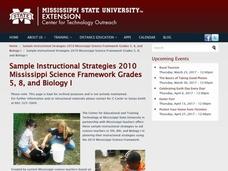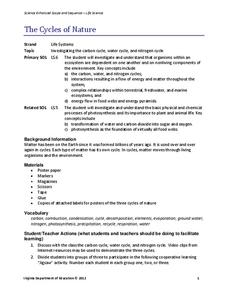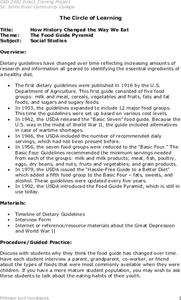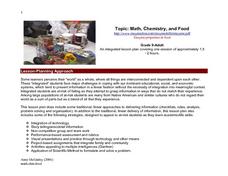Outdoor Learning Center
Outdoor Survival
Which of the following can you survive without for the longest time: water, food, or a positive mental attitude? The answer may surprise you. Guide learners of all ages through games, activities, and discussions about surviving in the...
Curated OER
Outdoor Survival
Students are introduced to basic outdoor survival concepts. They identify the seven basic needs for survival. Students describe the symptoms and treatment for frostbite and hypothermia. They compare and contrast the value of different...
Curated OER
Nutrition Awareness
High schoolers gain an awareness of nutrition. In this science lesson plan, students explore how to determine his or her ideal body weight, demonstrate familiarity with the food groups relating to kilocaloric content, estimate the basic...
Curated OER
Menu Math
Learners follow the food pyramid to create a daily food budget. They research food prices online or in newspapers. They graph the amount of each food group included in their menus. They can also create a weekly food menu based on a fixed...
Curated OER
Mathematics Through Nutrition
Students plan a meal including shopping, preparing and meal and serving it. They become aware of different foods from different ethnic backgrounds and describe the displays in the store and why the items are displayed as they are.
Virginia Department of Education
The Cycles of Nature
Encourage peer collaboration and assist with the creation of visual aids to identify carbon, water, and nitrogen cycles as your class learns more about nature. They discuss relative information, create a visual aid...
ARKive
Temperate Rainforest in the Pacific Northwest
Explore the amazing temperate rainforest of the Pacific Northwest. Your class starts by investigating the animals and plants of the Northwest, specifically Washington, and then research an animal population common to the area. In small...
Curated OER
Dietary Fiber
Students examine the different types of fiber and their benefits. For this investigative lesson students find good sources of fiber in different foods.
Curated OER
Microwave Introduction
Students take true and false pretest, and explore and practice basic principles of microwave cooking and how to use and care for it properly while preparing foods. Students watch teacher demonstration and then prepare their own bags of...
Curated OER
Life Cycles
Using computers, Students work in small groups and progress through the roles of Explorer, Researcher, Designer, and Evaluator as they study the life cycle of plants, insects, butterflies and frogs.
Curated OER
Carnivorous Plants
Pupils examine how carnivorous plants get their nutrients from animals. In this food web lesson plan students examine how the plants attract their prey and are given many onilne sources to research.
Curated OER
Biotechnology Projects and Writing Assignments
Students research a subject about biotechnology and do a project or a writing assignment on it. They can pick from a possible eighteen different projects and five different writing projects.
Curated OER
How History Changed the Way We Eat
Students participate in a lesson plan that is concerned with the history of the food pyramid and how it evolved and changed into its modern state. After being presented with the information they conduct classroom discussions about the...
Curated OER
Healthy Foods
Students illustrate their favorite food and add it to a food pyramid graph, after listening to Russell Hoban's story, Bread and Jam for Frances.
Curated OER
What Would You Take to Sea? Instructions for Teachers
Pupils, who are teachers, discover the hazards facing sailors hundreds of years ago as they prepare a lesson to use in their classroom. They examine what each group of students will investigate, and how the findings will be discussed.
Curated OER
Evidence of Photosynthesis
Hands on science is the way to go! Learners conduct a lab experiment to help them explain how plants make food through photosynthesis. They test for the presence of starch in leaves using iodine solution and identify the basic things...
Curated OER
Babysitting and Child Care
The first job most of us ever experienced, was babysitting. Prepare young adults for the responsibilities of child care with Babysitting 101. They'll discuss safety, food preparation, and the that responsibilities babysitting entails....
Polar Trec
Calorimetry Lab
Young people between the ages of 11–13 need on average about 2,000 calories per day. Within the lab, groups learn about calorimetry and respiration. They explore how it pertains to humans and animals living the Arctic where cold...
Missouri Department of Elementary
Ingredients of a Relationship Recipe
An eye-catching hook makes a smart analogy between ingredients for a food recipe and ingredients for quality relationships. Scholars discuss and list qualities they feel contribute to positive interactions. Pupils create a recipe card...
Curated OER
Semipermeable Membranes and Bioaccumulation
Beginning biologists place a drop of food coloring into water of differing temperatures to observe the effect on the diffusion rate. They remove the shells from raw eggs and then experiment with osmosis over the remaining membranes....
Curated OER
Strawberry DNA extraction
Students study the basic function of DNA and then extract it from strawberries. In this DNA extraction instructional activity students examine DNA and see why the extraction of it is so important to scientists.
Curated OER
Free Enterprise--Product Cost
Pupils apply basic math skills in computing a product cost.
Curated OER
Nutrition in Me!
Third graders explain the basic healthy eating and physical activity concepts. In this healthy lifestyles instructional activity, 3rd graders describe two main components of a healthy lifestyle, demonstrate two different types of...
Curated OER
Topic: Math, Chemistry, and Food
Learners listen as the teacher tells the story of Sisyphus rolling the stone up the mountain. Students prepare two batches of jello, one with fresh pineapple, and one with canned pineapple. While the jello is setting, learners work on...























